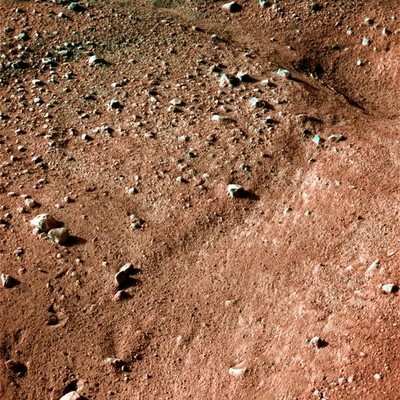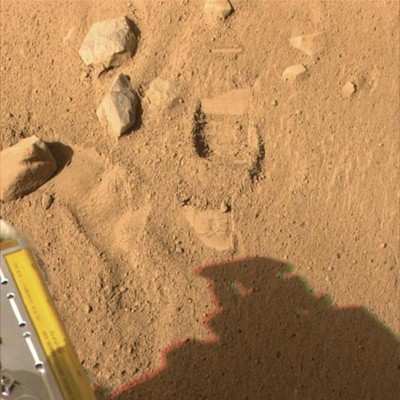Microscope Physically Examines Soil Particles
NASA said Thursday the agency's Phoenix Mars Lander has touched
Martian soil with a fork-like probe for the first time and begun
using a microscope that examines shapes of tiny particles by
touching them.

Phoenix's robotic arm pushed the fork-like probe's four spikes
into undisturbed soil Tuesday as a validation test of the insertion
procedure. The prongs of this thermal and electrical conductivity
probe are about 1.5 centimeters, or half an inch, long. The science
team will use the probe tool to assess how easily heat and
electricity move through the soil from one spike to another. Such
measurements can provide information about frozen or unfrozen water
in the soil.
The probe sits on a "knuckle" of the 2.35-meter-long
(7.7-foot-long) robotic arm. Held up in the air, it has provided
assessments of water vapor in the atmosphere several times since
Phoenix's May 25 landing on far-northern Mars. Researchers
anticipate getting the probe's first soil measurements following a
second placement into the ground, planned as part of today's
Phoenix activities on Mars.
Phoenix also has returned the first image from its atomic force
microscope. This Swiss-made microscope builds an image of the
surface of a particle by sensing it with a sharp tip at the end of
a spring, all microfabricated from a sliver of silicon. The sensor
rides up and down following the contour of the surface, providing
information about the target's shape.

"The same day we first touched a target with the thermal and
electrical conductivity probe, we first touched another target with
a needle about three orders of magnitude smaller -- one of the tips
of our atomic force microscope," said Michael Hecht of NASA's Jet
Propulsion Laboratory, Pasadena, Calif., lead scientist for the
suite of instruments on Phoenix that includes both the conductivity
probe and the microscopy station.
The atomic force microscope can provide details of soil-particle
shapes as small as about 100 nanometers, less than one-hundredth
the width of a human hair. This is about 20 times smaller than what
can be resolved with Phoenix's optical microscope, which has
provided much higher-magnification imaging than anything seen on
Mars previously.
The first touch of an atomic force microscope tip to a substrate
on the microscopy station's sample-presentation wheel served as a
validation test. The substrate will be used to hold soil particles
in place for inspection by the microscope. The microscope's first
imaging began Wednesday and produced a calibration image of a
grooved substrate. "It's just amazing when you think that the
entire area in this image fits on an eyelash. I'm looking forward
to exciting things to come," Hecht said.
With these developments in the past two days, the spacecraft has
put to use all the capabilities of its Microscopy, Electrochemistry
and Conductivity Analyzer, or MECA, suite of instruments.
Researchers have begun analyzing data this week from the second
sample of soil tested by MECA's wet chemistry laboratory.

Meanwhile, the Phoenix team is checking for the best method to
gather a sample of Martian ice to analyze using the lander's
Thermal and Evolved-Gas Analyzer, which heats samples and
identifies vapors from them. Researchers are using Phoenix's
robotic arm to clear off a patch of hard material uncovered in a
shallow trench informally called "Snow White." They plan in coming
days to begin using a motorized rasp on the back of the arm's scoop
to loosen bits of the hard material, which is expected to be rich
in frozen water.
The atomic force microscope for Phoenix was provided by a
consortium led by the University of Neuchatel,
Switzerland.
 ANN's Daily Aero-Term (04.20.24): Light Gun
ANN's Daily Aero-Term (04.20.24): Light Gun Aero-News: Quote of the Day (04.20.24)
Aero-News: Quote of the Day (04.20.24) ANN's Daily Aero-Linx (04.21.24)
ANN's Daily Aero-Linx (04.21.24) Aero-News: Quote of the Day (04.21.24)
Aero-News: Quote of the Day (04.21.24) ANN's Daily Aero-Term (04.21.24): Aircraft Conflict
ANN's Daily Aero-Term (04.21.24): Aircraft Conflict





